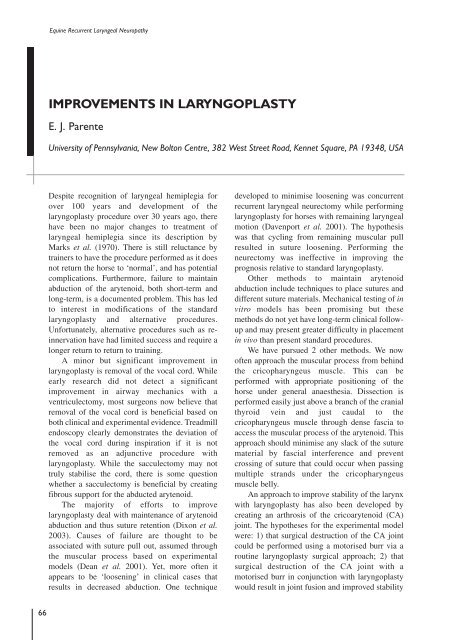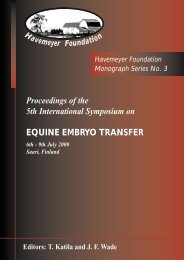Proceedings of a Workshop on - The Havemeyer Foundation
Proceedings of a Workshop on - The Havemeyer Foundation
Proceedings of a Workshop on - The Havemeyer Foundation
Create successful ePaper yourself
Turn your PDF publications into a flip-book with our unique Google optimized e-Paper software.
Equine Recurrent Laryngeal Neuropathy<br />
IMPROVEMENTS IN LARYNGOPLASTY<br />
E. J. Parente<br />
University <str<strong>on</strong>g>of</str<strong>on</strong>g> Pennsylvania, New Bolt<strong>on</strong> Centre, 382 West Street Road, Kennet Square, PA 19348, USA<br />
Despite recogniti<strong>on</strong> <str<strong>on</strong>g>of</str<strong>on</strong>g> laryngeal hemiplegia for<br />
over 100 years and development <str<strong>on</strong>g>of</str<strong>on</strong>g> the<br />
laryngoplasty procedure over 30 years ago, there<br />
have been no major changes to treatment <str<strong>on</strong>g>of</str<strong>on</strong>g><br />
laryngeal hemiplegia since its descripti<strong>on</strong> by<br />
Marks et al. (1970). <strong>The</strong>re is still reluctance by<br />
trainers to have the procedure performed as it does<br />
not return the horse to ‘normal’, and has potential<br />
complicati<strong>on</strong>s. Furthermore, failure to maintain<br />
abducti<strong>on</strong> <str<strong>on</strong>g>of</str<strong>on</strong>g> the arytenoid, both short-term and<br />
l<strong>on</strong>g-term, is a documented problem. This has led<br />
to interest in modificati<strong>on</strong>s <str<strong>on</strong>g>of</str<strong>on</strong>g> the standard<br />
laryngoplasty and alternative procedures.<br />
Unfortunately, alternative procedures such as reinnervati<strong>on</strong><br />
have had limited success and require a<br />
l<strong>on</strong>ger return to return to training.<br />
A minor but significant improvement in<br />
laryngoplasty is removal <str<strong>on</strong>g>of</str<strong>on</strong>g> the vocal cord. While<br />
early research did not detect a significant<br />
improvement in airway mechanics with a<br />
ventriculectomy, most surge<strong>on</strong>s now believe that<br />
removal <str<strong>on</strong>g>of</str<strong>on</strong>g> the vocal cord is beneficial based <strong>on</strong><br />
both clinical and experimental evidence. Treadmill<br />
endoscopy clearly dem<strong>on</strong>strates the deviati<strong>on</strong> <str<strong>on</strong>g>of</str<strong>on</strong>g><br />
the vocal cord during inspirati<strong>on</strong> if it is not<br />
removed as an adjunctive procedure with<br />
laryngoplasty. While the sacculectomy may not<br />
truly stabilise the cord, there is some questi<strong>on</strong><br />
whether a sacculectomy is beneficial by creating<br />
fibrous support for the abducted arytenoid.<br />
<strong>The</strong> majority <str<strong>on</strong>g>of</str<strong>on</strong>g> efforts to improve<br />
laryngoplasty deal with maintenance <str<strong>on</strong>g>of</str<strong>on</strong>g> arytenoid<br />
abducti<strong>on</strong> and thus suture retenti<strong>on</strong> (Dix<strong>on</strong> et al.<br />
2003). Causes <str<strong>on</strong>g>of</str<strong>on</strong>g> failure are thought to be<br />
associated with suture pull out, assumed through<br />
the muscular process based <strong>on</strong> experimental<br />
models (Dean et al. 2001). Yet, more <str<strong>on</strong>g>of</str<strong>on</strong>g>ten it<br />
appears to be ‘loosening’ in clinical cases that<br />
results in decreased abducti<strong>on</strong>. One technique<br />
developed to minimise loosening was c<strong>on</strong>current<br />
recurrent laryngeal neurectomy while performing<br />
laryngoplasty for horses with remaining laryngeal<br />
moti<strong>on</strong> (Davenport et al. 2001). <strong>The</strong> hypothesis<br />
was that cycling from remaining muscular pull<br />
resulted in suture loosening. Performing the<br />
neurectomy was ineffective in improving the<br />
prognosis relative to standard laryngoplasty.<br />
Other methods to maintain arytenoid<br />
abducti<strong>on</strong> include techniques to place sutures and<br />
different suture materials. Mechanical testing <str<strong>on</strong>g>of</str<strong>on</strong>g> in<br />
vitro models has been promising but these<br />
methods do not yet have l<strong>on</strong>g-term clinical followup<br />
and may present greater difficulty in placement<br />
in vivo than present standard procedures.<br />
We have pursued 2 other methods. We now<br />
<str<strong>on</strong>g>of</str<strong>on</strong>g>ten approach the muscular process from behind<br />
the cricopharyngeus muscle. This can be<br />
performed with appropriate positi<strong>on</strong>ing <str<strong>on</strong>g>of</str<strong>on</strong>g> the<br />
horse under general anaesthesia. Dissecti<strong>on</strong> is<br />
performed easily just above a branch <str<strong>on</strong>g>of</str<strong>on</strong>g> the cranial<br />
thyroid vein and just caudal to the<br />
cricopharyngeus muscle through dense fascia to<br />
access the muscular process <str<strong>on</strong>g>of</str<strong>on</strong>g> the arytenoid. This<br />
approach should minimise any slack <str<strong>on</strong>g>of</str<strong>on</strong>g> the suture<br />
material by fascial interference and prevent<br />
crossing <str<strong>on</strong>g>of</str<strong>on</strong>g> suture that could occur when passing<br />
multiple strands under the cricopharyngeus<br />
muscle belly.<br />
An approach to improve stability <str<strong>on</strong>g>of</str<strong>on</strong>g> the larynx<br />
with laryngoplasty has also been developed by<br />
creating an arthrosis <str<strong>on</strong>g>of</str<strong>on</strong>g> the cricoarytenoid (CA)<br />
joint. <strong>The</strong> hypotheses for the experimental model<br />
were: 1) that surgical destructi<strong>on</strong> <str<strong>on</strong>g>of</str<strong>on</strong>g> the CA joint<br />
could be performed using a motorised burr via a<br />
routine laryngoplasty surgical approach; 2) that<br />
surgical destructi<strong>on</strong> <str<strong>on</strong>g>of</str<strong>on</strong>g> the CA joint with a<br />
motorised burr in c<strong>on</strong>juncti<strong>on</strong> with laryngoplasty<br />
would result in joint fusi<strong>on</strong> and improved stability<br />
66








